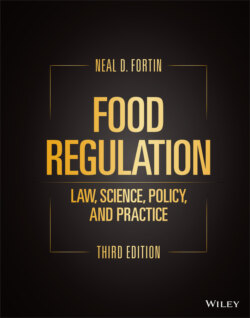Читать книгу Food Regulation - Neal D. Fortin - Страница 93
DISCUSSION QUESTIONS
Оглавление1 2.2 Bottled water. Within the meaning of the FD&C Act, could bottled water be characterized as a food, a drug, or both? How? Would your answer change if the product were cherry juice concentrate?
2 2.3 Blackboard chalk. When would blackboard chalk be a drug?
3 2.4 “SkyHigh” brand glue is not only efficacious as glue, but is widely known to induce a high when sniffed. The manufacturer advertises the adhesive properties of the glue heavily in magazines that are popular in the drug culture. Can FDA regulate the glue?
4 2.5 Statutory drafting. Is the definition of “food” good statutory drafting?
5 2.6 Coffee is often consumed for its stimulant effect. Coffee is not con sumed for its nutritional value. If a manufacturer promoted its coffee for the stimulant effect, would it be a drug?
6 2.7 Caffeine is regulated as an over‐the‐counter drug when sold as a stimulant pill. 21 C.F.R. § 340. However, FDA does not regulate caffeine added to foods as a drug—even when the food is promoted as a stimulant. How do you reconcile the agency’s decision? Is this exception within the scope of the structure/function exception for foods within FD&CA § 201(g)(1)(C)?
7 2.8 Putrid and decomposed food that is clearly inedible would not be called “food” in everyday speech. What would be the regulatory consequence if putrid and decomposed food were excluded from the definition of food?
8 2.9 Vitamins and minerals without therapeutic claims have generally been classified as foods. However, in the 1970s, reports of human toxicity emerged from consumption of large doses of the vitamins A and D. These fat‐soluble vitamins create special concern because they can accumulate in the fatty tissue. To deal with this problem, in 1972 and 1973, FDA promulgated regulations classifying certain high dosages of vitamin A and D as drugs and requiring that they be sold by prescription. 37 Fed. Reg. 26618 (Dec 14, 1972) and 38 Fed. Reg. 20723 (Aug 2, 1973). However, in National Nutritional Foods Ass’n v. Mathews, 557 F.2d 325 (2d Cir. 1977), the court questioned FDA’s approach and found FDA’s administrative record incomplete. In particular, the court questioned whether FDA could classify vitamins as drugs when no intended therapeutic use was offered by the vendors, the labeling, or any promotional material. The court upheld the regulations, but FDA nonetheless later rescinded them. 43 Fed. Reg. 10551 (Mar 14, 1978).
